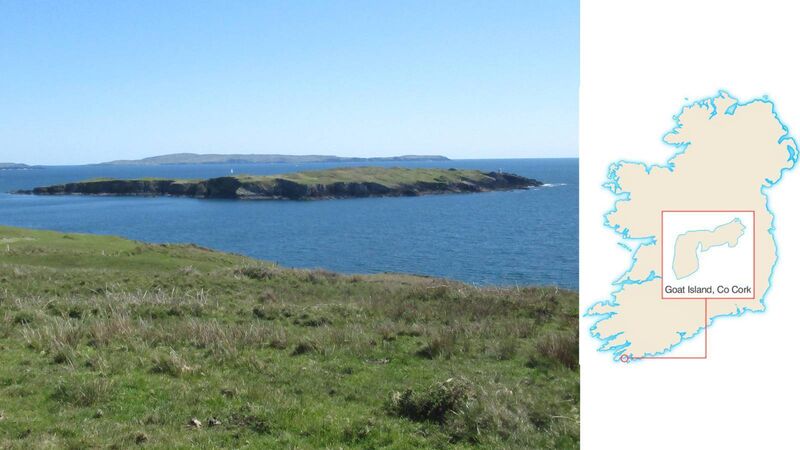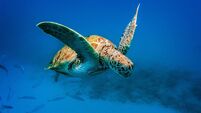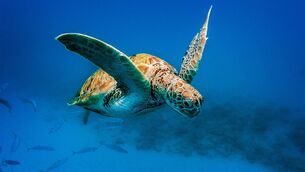Islands of Ireland: Both of Cork's Goat Islands are pretty inhospitable

Islands of Ireland: Goat Island, Long Island Bay, West Cork with Cape Clear in the background. Picture: Dan MacCarthy
This is a case of the little un outshining the big un — like David winning over Goliath.
Goat Island Little and Goat Island lie in Long Island Bay which is contiguous with Roaringwater Bay in West Cork. The two bays are at the western end of the multitude of islands that form part of Carbery’s Hundred Isles. The uninhabited, L-shaped, Rathlin Island-impersonating Goat Island is a formidable place with its high cliffs belying their 33m stature. Goat Island Little, is also uninhabited but has a significant navigational purpose through its beacon which was built in 1864.
Though Goat Island has a couple of very small strands they are overlooked by steep cliffs and though not of imposing height they are practically unscalable for the circumference of the island, making a tramp around all but impossible.
However, when land was in extremely short supply during the Famine, places such as Goat Island were availed of by people desperate to survive on any such scrap they could find. Botanist John Akeroyd wrote in ‘Sherkin Comment’ a few years ago that “all the smaller islands [of Roaringwaterbay and Long Island Bay] however bleak and rocky, have some vegetation clinging on in mostly thin stony or peaty or sandy soils, requiring seabirds and the vagaries of the tides to introduce nutrients in the form of seaweed, guano, seashells and crab debris. Few have been or are inhabited. Remains of a croft or farm on Goat Island are a tragic reminder of how people once lived at the very limits of cultivation and survival”.
Akeroyd’s study encompassed the two Goat Islands, Badger Island between Cape and Sherkin, and several other islets at Turk Head including the Catalogues, Quarantine and Jeremy.
Goat Island is characterised by what are known as zawns in Cornwall and some other parts of England: deep fissures caused by erosion that run from sea level to the top of the cliffs.
The 19th-century Ordnance Survey map lists at least four sea arches, the most prominent of which is in the centre of the island. In fact, the passage of time will eventually see the collapse of this arch and two distinct islands being made from the larger Goat, amounting to a small herd when Goat Little is included. The link between the two halves leaves barely enough room for, well a goat, to pass across. These early maps show three distinct buildings on the eastern end (or easter in local parlance), one of which was likely a dwelling with the other two outhouses for animals.
There are also clearly defined lazy beds indicating a subsistence lifestyle probably supplemented by fishing. Still, survival must have been on the extreme end of the spectrum. Without trees for shelter from the worst of the storms or even a small pier to get to the mainland for help, the occupants would have experienced some harsh times there. Griffiths Valuation shows Goat Island and its little brother as being under the ownership of a Cornelius Moynihan in the mid-19th century.
Interestingly, the east is also the site of the island’s two archaeological finds, both the remains of promontory forts dating from the Iron Age, roughly between 500BC to 400 AD. These forts were largely defensive earthen and stone mounds. The more obvious position on Goat Island would have been looking out to sea from the western end, so it is a curiosity to see them in the less obvious place.
There are many other goat islands in the country, often very, very small and not registered on ‘comprehensive’ island lists. Goat Island near Ardmore, County Waterford being one such. There are several on lakes including at Lough Ree on the River Shannon. The Irish for Goats' Island is not Oileáin na Gabhair but Oileán Clutharach or Sheltered Island. With its numerous zawns and sparse vegetation it can only be marvelled at why someone thought it apt to describe it thus. Its inhospitableness is its calling card and its resident goat population must be well pleased with that.
: Goat Island and Goat Island Little are under private ownership. Inquire for tours at Schull Seasafari
: John Akeroyd: The Smaller Islands of Roaringwater Bay, , No 63.








